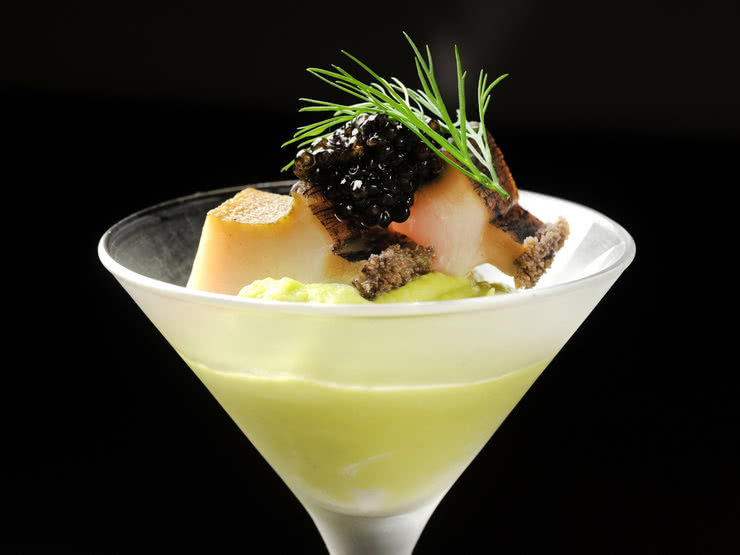![The Elegant Food of French-Japanese Fusion Cuisine]()
From flashy Michelin-starred establishments to cozy neighborhood bistros, the Japanese culinary affair with French cuisine is extensive. Japanese chefs have travelled to France to study cooking since the Meiji and Taisho Eras, and in the years since the 1960s those numbers have increased dramatically. These French-trained Japanese chefs bring with them the flavors and techniques of traditional French cuisine, as well as the influences of the ‘nouvelle’ cuisine that has become the gold standard in France since the 1920s, with its ingredient-focussed dishes, refined presentation and healthful emphasis.
Continue reading The Elegant Food of French-Japanese Fusion Cuisine
![Best Teppanyaki in Tokyo: 7 Sizzlingly Stellar Restaurants]()
Teppanyaki is a modern style of Japanese dining akin to dinner theater, with skilled chefs displaying graceful culinary techniques as they grill high-quality meat, seafood, and vegetables with style and flair. Sometimes dubbed “hibachi” outside of Japan, teppanyaki means “grilled on an iron surface” and refers to the open cooktop where chefs typically prepare the meal before their delighted guests. Based on traditional Japanese open griddle cooking, teppanyaki originated in the 1940s as Japan’s take on the American steakhouse and quickly spread overseas. What better place to enjoy a world-class teppanyaki experience than in one of the most exciting, modern and most gastronomically adventurous cities in the world? Here are 9 restaurants representing some of the best teppanyaki in Tokyo.
Continue reading Best Teppanyaki in Tokyo: 7 Sizzlingly Stellar Restaurants
![Hiroshima Sushi Restaurants: 8 Paragons of Coastal Cuisine]()
Explore one of Japan’s most diverse culinary scenes in Hiroshima, located on the westernmost part of Japan’s main island. Bordered by the Seto Inland Sea, the southern Hiroshima coastline is dotted with numerous fishing villages and more than 100 tiny islands. Hiroshima produces two-thirds of Japan’s oysters and enjoys a huge bounty of fish and shellfish that vary throughout the year. The area’s unique geography is home to a rich, biodiverse ocean environment, rewarding it with some of the best seafood in the country. Here are 8 Hiroshima sushi restaurants where one can sample the finest coastal cuisine the area has to offer.
Continue reading Hiroshima Sushi Restaurants: 8 Paragons of Coastal Cuisine
![Kyoto Sushi Restaurant Guide: 8 Seafood Gems of Old Japan]()
A city renowned for its spiritual and artistic tradition, Kyoto is also home to a storied culinary history—including a unique sushi culture unlike any other. As a landlocked city, Kyoto traditionally did not have access to fresh fish, which fostered an inventive Kyoto style of sushi emphasizing preserved and pickled ingredients. Following the Great East Japan Earthquake of 1923, however, displaced sushi chefs came to Kyoto and brought with them the familiar Edo-mae (Tokyo) style sushi of fresh fish atop a ball of rice. Kyoto sushi has since evolved to incorporate aspects of both traditional Kyoto dining—with its emphasis on high-quality, local, seasonal ingredients—and Edo-mae sushi techniques. Here are 8 must-try Kyoto sushi restaurants that combine the peerless tradition of yesterday with the tastes of today.
Continue reading Kyoto Sushi Restaurant Guide: 8 Seafood Gems of Old Japan
![Kamakura Restaurants: 8 Eateries both Bold and Traditional]()
Located not too far outside of Tokyo by train is the historic seaside town of Kamakura, a special place that still echoes of old Japan. With its over-40-foot-tall bronze statue of the Great Buddha, picturesque beaches, friendly locals, slower pace of living, and fantastic photo opportunities, Kamakura is a favorite sightseeing destination. Where the town itself is traditional, the cuisine is often bold, expertly combining European influences with ancient Japanese favorites. For travelers planning to visit this hidden gem, here are 8 essential Kamakura restaurants to add to the itinerary.
Continue reading Kamakura Restaurants: 8 Eateries both Bold and Traditional






